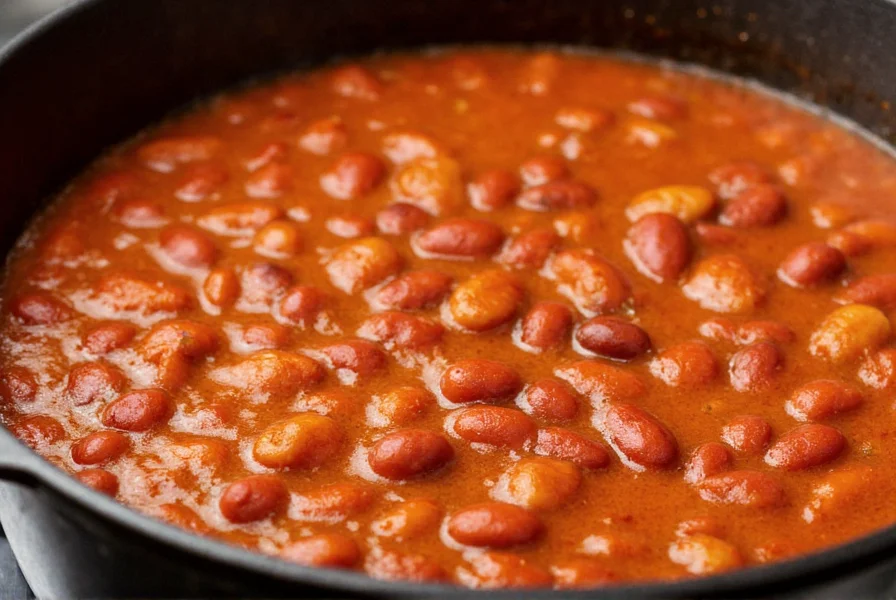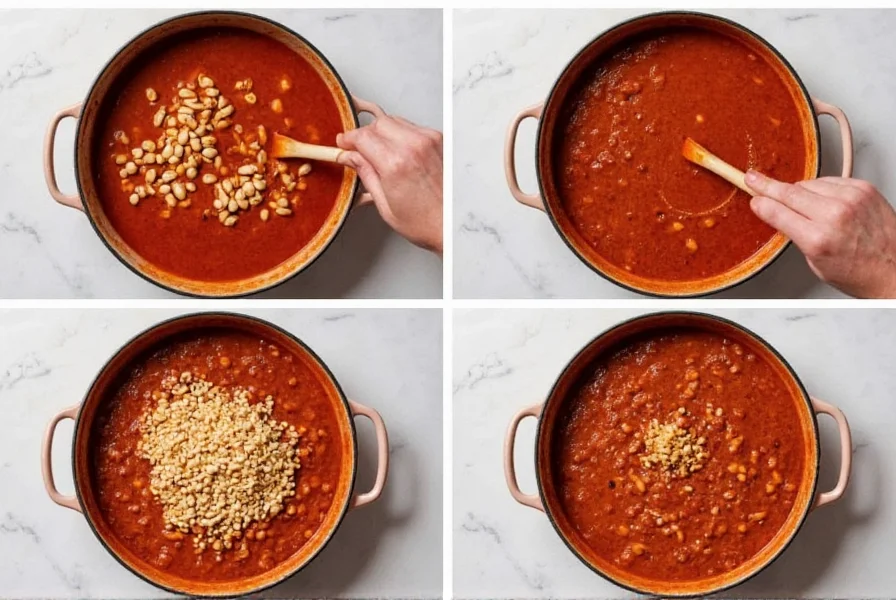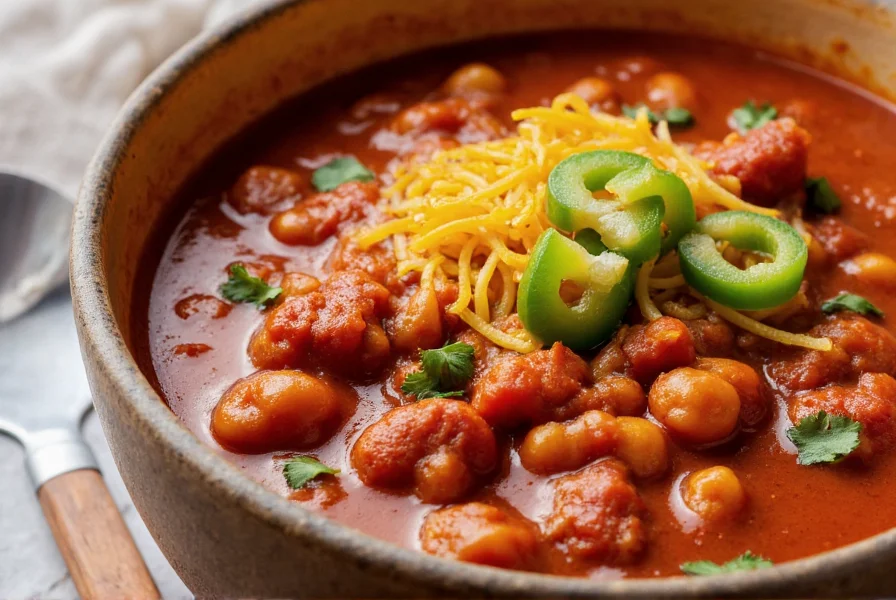The Great Beans-in-Chili Debate: History and Context
Understanding the controversy surrounding beans in chili requires examining its historical roots. Traditional Texas-style chili con carne (literally "chili with meat") emerged in the late 19th century among cowboys and ranchers who relied on dried beef, fat, and chili peppers as their primary ingredients. Beans weren't part of this original preparation due to their perishability on long cattle drives.
However, as chili spread across America in the 20th century, home cooks began incorporating beans for practical reasons—they were affordable, shelf-stable, and added nutritional value. By the 1930s, chili with beans had become the standard version served at diners, school cafeterias, and community events throughout most of the United States, while Texas maintained its bean-free tradition.
| Chili Style | Bean Policy | Regional Popularity | Key Characteristics |
|---|---|---|---|
| Texas Red | No beans | Texas, Oklahoma | Meat-focused, rich broth, complex chili powder blend |
| American-Style | Beans included | Nationwide | Heartier texture, more balanced nutrition, easier home preparation |
| Cincinnati-Style | Beans optional | Ohio region | Served over spaghetti, with oyster crackers and cheese |
Why Beans Enhance Most Home Kitchen Chili Recipes
While purists may frown upon beans in chili, practical considerations make chili with kidney beans or pinto beans an excellent choice for most home cooks:
- Nutritional balance - Beans add fiber and plant-based protein, creating a more complete meal
- Texture improvement - They provide pleasant contrast to the ground meat or shredded beef
- Cost efficiency - Beans stretch the meat portion while maintaining satisfaction
- Flavor absorption - Beans soak up the complex spices and tomato elements
- Meal prep friendly - Bean-based chili reheats exceptionally well
Professional chefs who incorporate beans into their chili recipes emphasize using high-quality canned beans rinsed thoroughly to remove excess sodium and the starchy liquid that can cloud the chili. Alternatively, cooking dried beans separately with minimal seasoning preserves their structural integrity when added to the chili pot.

Best Beans for Chili: A Practical Comparison
Not all beans perform equally well in chili. Here's how the most common varieties measure up for making chili with beans:
- Kidney beans - The classic choice with excellent shape retention and meaty texture that holds up to long simmering
- Pinto beans - Traditional in Southwestern recipes, they develop a creamy interior while maintaining structure
- Black beans - Offer earthy flavor and striking visual contrast, best for Tex-Mex style chili
- Cannellini beans - A white bean option for lighter chili variations, with delicate flavor
- Great Northern beans - Similar to cannellini but slightly larger, excellent for absorbing complex flavors
For authentic chili con carne with beans, many chefs recommend using a combination of kidney and pinto beans to achieve both visual interest and textural complexity. Avoid smaller beans like navy or black-eyed peas, which tend to disintegrate during the cooking process.
Perfect Homemade Chili with Beans Recipe
This tested recipe delivers restaurant-quality chili with beans and ground beef that balances rich flavor with perfect bean texture. Serves 6-8.
Ingredients
- 2 lbs ground chuck (80% lean)
- 1 large yellow onion, finely diced
- 1 bell pepper, finely diced
- 4 cloves garlic, minced
- 2 (15oz) cans kidney beans, rinsed and drained
- 1 (28oz) can crushed tomatoes
- 2 cups beef broth
- 2 tbsp chili powder
- 1 tbsp cumin
- 2 tsp smoked paprika
- 1 tsp oregano
- 1 chipotle pepper in adobo, minced
- Salt and black pepper to taste
- 1 tbsp masa harina (optional, for thickening)
Step-by-Step Instructions
- Brown the ground beef in a large Dutch oven over medium-high heat, breaking into small crumbles. Drain excess fat but retain about 2 tablespoons for flavor.
- Add onions and bell peppers, cooking until softened (about 5 minutes). Stir in garlic and cook for 1 minute until fragrant.
- Stir in chili powder, cumin, smoked paprika, and oregano, cooking for 1 minute to toast the spices.
- Add crushed tomatoes, beef broth, and chipotle pepper. Bring to a simmer and cook uncovered for 45 minutes, stirring occasionally.
- Stir in rinsed kidney beans and continue simmering for 15-20 minutes (critical step for chili with beans that aren't mushy).
- Season with salt and black pepper. For thicker chili, stir in masa harina and cook 5 minutes more.
- Remove from heat and let rest 15 minutes before serving to allow flavors to meld.

Common Mistakes When Making Chili with Beans
Avoid these pitfalls to ensure your easy chili with beans turns out perfectly every time:
- Adding beans too early - Beans added at the beginning of cooking become mushy. Always add during the final 15-20 minutes.
- Skipping the spice-toasting step - Dry spices need brief cooking in fat to release their full flavor potential.
- Over-stirring after adding beans - Excessive stirring breaks beans apart. Gently fold them in and stir minimally.
- Using low-quality canned beans - Premium brands maintain better texture. Rinse thoroughly to remove excess sodium.
- Not allowing resting time - Chili always tastes better after flavors have time to meld (minimum 15 minutes off heat).
Serving Suggestions and Variations
Traditional chili with beans recipe shines with simple toppings that complement rather than overwhelm:
- Freshly grated cheddar or Monterey Jack cheese
- Thinly sliced green onions
- Crushed oyster crackers or cornbread on the side
- A dollop of sour cream or Greek yogurt
- Fresh cilantro leaves
For dietary variations:
- Vegan chili with beans - Substitute textured vegetable protein for meat and use vegetable broth
- White chicken chili with beans - Use shredded chicken, white beans, and green chilies
- Slow cooker chili with beans - Brown meat first, then cook on low 6-8 hours, adding beans in the last hour
Frequently Asked Questions
Do beans belong in authentic chili?
Authentic Texas-style chili con carne traditionally contains no beans, focusing solely on meat and chili peppers. However, chili with beans has been a standard preparation across most of the United States since the early 20th century and is considered authentic by many regional traditions beyond Texas.
How do I keep beans from getting mushy in chili?
Add rinsed canned beans during the final 15-20 minutes of cooking. If using dried beans, cook them separately until just tender before adding to the chili. Avoid vigorous stirring after adding beans to prevent breakage.
What's the best bean for chili with ground beef?
Kidney beans are the most traditional choice for chili with ground beef due to their hearty texture and ability to maintain shape during cooking. Pinto beans also work well and are common in Southwestern preparations. Many chefs recommend using a combination of both for optimal texture and visual appeal.
Can I make chili with beans in a slow cooker?
Yes, but with careful timing. Brown the meat and sauté vegetables first, then transfer to the slow cooker with all ingredients EXCEPT the beans. Cook on low for 6-8 hours, then stir in rinsed beans and cook 30-60 minutes more. Adding beans too early results in mushy texture.
Is chili with beans healthy?
Chili with beans offers a nutritionally balanced meal with lean protein from both meat and beans, dietary fiber from beans and vegetables, and lycopene from tomatoes. Using lean ground beef, low-sodium beans, and plenty of vegetables creates a hearty dish that's both satisfying and nutritious.











 浙公网安备
33010002000092号
浙公网安备
33010002000092号 浙B2-20120091-4
浙B2-20120091-4